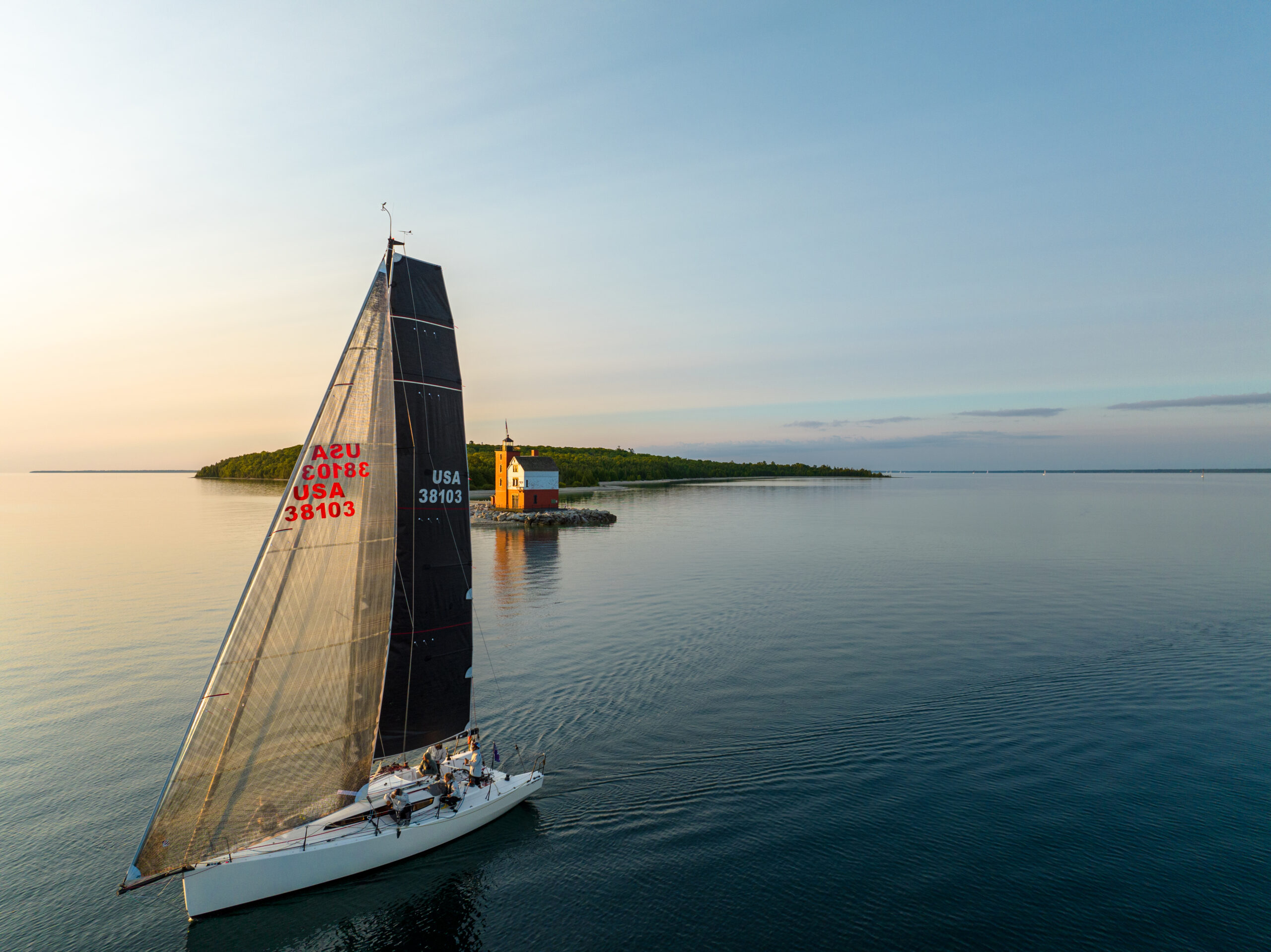By Andy Camarda
In the previous article in this two-part series, I discussed how I took a 30-year-old racer/cruiser from the boatyard to the podium on Mackinac Island. If you haven’t yet read that story, follow the link HERE.
After the blisteringly fast Chicago Mac race, I turned my attention to the 100th anniversary Bayview Mackinac Race. With over 300 boats entered, it was set to be the highest attendance in the race’s history. All divisions were set to race the original shore course, hugging the eastern shore of Michigan all the way underneath the island of Bois Blanc and crossing the finish line from west to east. This course proved to be a challenging endeavor, as the wind along the shore was much more unpredictable than the Cove Island course, which took the racing division further offshore. With more boats packed into the Black River than ever before, Port Huron sent off the sleep-deprived sailors in typical Bayview style with music blaring until the wee hours of the morning. The next morning, competitors were greeted by a calm, placid Lake Huron. The race committee made the rare decision to delay the starts and wait for an unforeseen easterly breeze to gently fill the lake.
Before we get too far into the race, let’s talk about the boat in question: the JPK 1080. Designed and built in France, the JPK 1080 is an offshore speedster with a wide, powerful hull and dual rudders. Purpose built for heavy air sailing with a shorthanded crew, the boats are known for rating well in both IRC and ORC but have rarely been raced in light air venues. Smoke Show, owned by Jake Thomas, is one of only a few JPK’s in the states and may very well be the first JPK to sail in freshwater. With hard chines and lots of volume in the bow, the 1080 sails at its best while reaching in heavy air, a not-so-common occurrence here in the Great Lakes. As it would turn out, that wide, powerful hull would prove to be sticky in light air, especially with a smaller rig purpose-built for big breeze. Going into this project, Jake and I agreed that the challenge ahead would be adding a considerable amount of sail area while maintaining the boat’s favorable ORC rating.
The mission: Take a boat designed for shorthanded, heavy-air ocean racing and turn it into a fully crewed, Great Lakes machine. It may sound crazy, but I can assure you that─ never mind… it might actually just be crazy. Nevertheless, we got down to business. With our “go big or go home” mentality, we started by converting the stock, pinhead mainsail to a massive square-top while also extending the foot length of the sail on the boom. Doing this pushed more sail area up the relatively short rig, a move which would prove helpful in heeling the boat and reducing the wetted-surface of the hull in light air. With two reef points and a mast car system, sail area could still be easily reduced in a blow. If I’m being honest, I thought we might have gone too big after hoisting the sail for the first time, as it was almost 20% larger than the original. However, I was impressed by how stable the boat felt in big breeze.
For upwind sailing, we skipped the light air jib and instead opted for a Code Zero like we did with Big Meanie. We designed a 65% mid-girth J0 to be sheeted inboard to the jib leads and maxxed out the area from the tip of the pole to the masthead. From there, we would go straight to an all-purpose (AP) jib on a furler to simplify sailing and reduce weight onboard. The J0 proved to be a weapon in this year’s light air Bayview race. Not only was it great at keeping the boat heeled over and moving in lighter breeze, we were able to carry it upwind in over 10 knots. If the wind had picked up more than that, we were confident that we could’ve reefed the main and continued to carry the J0 thanks to the boat’s righting moment.
We knew the boat would be plenty fast off the wind given the nature of its design, so we played it safe and went with a conventionally-sized A2 spinnaker. With the supersized mainsail, we did not need to add a lot of sail area for optimal downwind performance given that the rating was very sensitive to additional spinnaker area on the test ORC certificates. The recipe for our secret sauce included two more key ingredients: both a spinnaker staysail and a genoa staysail (and separate tack points on the deck so they could fly at the same time). Anytime we had breeze over 6 knots and were not beating upwind, one if not both sails were flying. Going downwind, this allowed us to get more area for free under the spinnaker. Given that the J0 is smaller than a traditional Code Zero to allow it to be trimmed in front of the spreaders, adding a genoa staysail inside the J0 helped extend the range of the sail and allowed us to carry fewer sails onboard.

The race was a show of three acts. Following a lengthy postponement, we started in light and variable conditions, filling to medium-air running and eventually reaching across Saginaw Bay. The second act was a long drift across the top of the state as we turned west, wrapping up with the grand finale: a cat-and-mouse game of dodging holes and connecting puffs through the channel underneath Bois Blanc.
For the variable winds at the start, the J0 proved to be the best sail to keep the boat moving until the breeze filled in. Having more area up high in the mainsail and using the J0 while our competitors languished with jibs extended us into the new breeze so we could set the A2 and spinnaker staysail earlier than most. The boat was happy downwind, allowing us to be conservative with our tactics and gybe back to the middle of the course on the small shifts to consolidate our leverage on the fleet.

For the reaching portion of the race, Smoke Show was in her element and seemed pleased with the added sail area, taking the extra horsepower with ease. We played with different configurations a few times as the wind shifted forward and aft, but we generally had at least one staysail flying inside the A2 or J0. Throughout the race, our “go big or go home” mindset prevailed. We kept the bow team busy at every opportunity and hoisted as much sail area as possible to keep the boat heeled and happy.
Unfortunately, the good times came to an end as we ground to halt near the scenic cement plant at Rogers City. If you’ve ever been to Roger City (or smelled it), you know what I’m talking about. Perhaps it was the view that inspired us to get away from there as fast as possible, which at the time was about 3 knots. We used the J0 and spinnaker staysail the rest of the way. Whenever the boat stopped, we would furl the J0 and use the staysail as a wind seeker. Once we got the boat moving 2 knots, we’d roll out the J0. Having both sails on furlers made the many sail changes quick and easy without anyone needing to move around the boat.
As the sun rose on Monday morning, we limped across the line with a significant lead and were able to give Smoke Show a division win in her first ever Mac Race. With plenty of breeze in the channel where the race usually finishes, the rest of our division sat floating for hours in the windless vortex between Bois Blanc and mainland Michigan. On a more optimistic note, I’m pleased to say that the mission was accomplished. It is, in fact, possible to take a boat out of its element and race in a setting that many would say is inappropriate for the design and specifications. And win, at that. Of course, the lesson is much the same as it was in the last article about the Chicago Mac. You don’t need paid professionals or a complex sail inventory to win under ORC. Simple is often better, lighter, and faster.
At Evolution Sails, we’re not only dedicated to providing you with a race-winning sail inventory, but also making sure you know how and when to use it. Keep an eye out for more articles like this on how to optimize for ORC. If there’s a topic you want to learn more about related to ORC optimization and sail inventory, reach out and let us know so we can address it in the next article.



